Engineering Research Methods: Seawater Hydrogen Fuel Project
VerifiedAdded on 2022/10/11
|17
|3609
|12
Report
AI Summary
This engineering research report investigates the feasibility of using seawater to generate hydrogen as a fuel source for vehicle engines. The study explores the concept of seawater hydrolysis, where the salts present in seawater facilitate the production of hydrogen gas. The report addresses the problem of pollution and high costs associated with traditional fossil fuels, proposing seawater as a cleaner and cheaper alternative. The methodology involves analyzing the process of hydrogen generation, including the use of solar panels to power the hydrolysis process, and the potential use of hydrogen in fuel cells to start the vehicle. The report includes a timeline, analysis of the technology, and a Gantt chart for project management. The goal is to determine if seawater can effectively power a vehicle, contributing to reduced air pollution and a more sustainable future. The report also includes mathematical equations and diagrams illustrating the process. The research aims to prove the use of seawater to reduce pollution and cost.

ENGINEERING RESEARCH METHODS 1
ENGINEERING RESEARCH METHODS
By Name
Course
Instructor
Institution
Location
Date
ENGINEERING RESEARCH METHODS
By Name
Course
Instructor
Institution
Location
Date
Paraphrase This Document
Need a fresh take? Get an instant paraphrase of this document with our AI Paraphraser
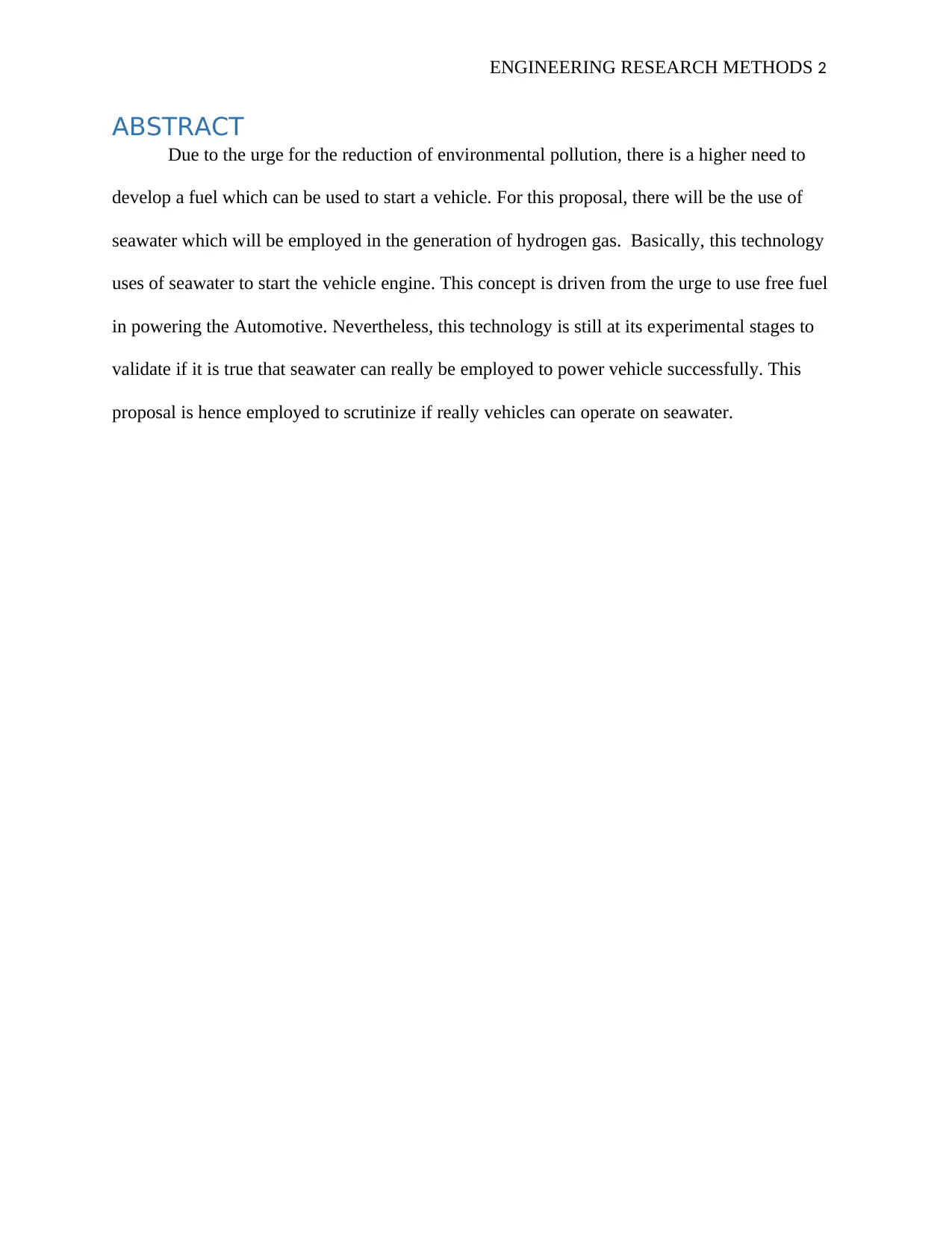
ENGINEERING RESEARCH METHODS 2
ABSTRACT
Due to the urge for the reduction of environmental pollution, there is a higher need to
develop a fuel which can be used to start a vehicle. For this proposal, there will be the use of
seawater which will be employed in the generation of hydrogen gas. Basically, this technology
uses of seawater to start the vehicle engine. This concept is driven from the urge to use free fuel
in powering the Automotive. Nevertheless, this technology is still at its experimental stages to
validate if it is true that seawater can really be employed to power vehicle successfully. This
proposal is hence employed to scrutinize if really vehicles can operate on seawater.
ABSTRACT
Due to the urge for the reduction of environmental pollution, there is a higher need to
develop a fuel which can be used to start a vehicle. For this proposal, there will be the use of
seawater which will be employed in the generation of hydrogen gas. Basically, this technology
uses of seawater to start the vehicle engine. This concept is driven from the urge to use free fuel
in powering the Automotive. Nevertheless, this technology is still at its experimental stages to
validate if it is true that seawater can really be employed to power vehicle successfully. This
proposal is hence employed to scrutinize if really vehicles can operate on seawater.
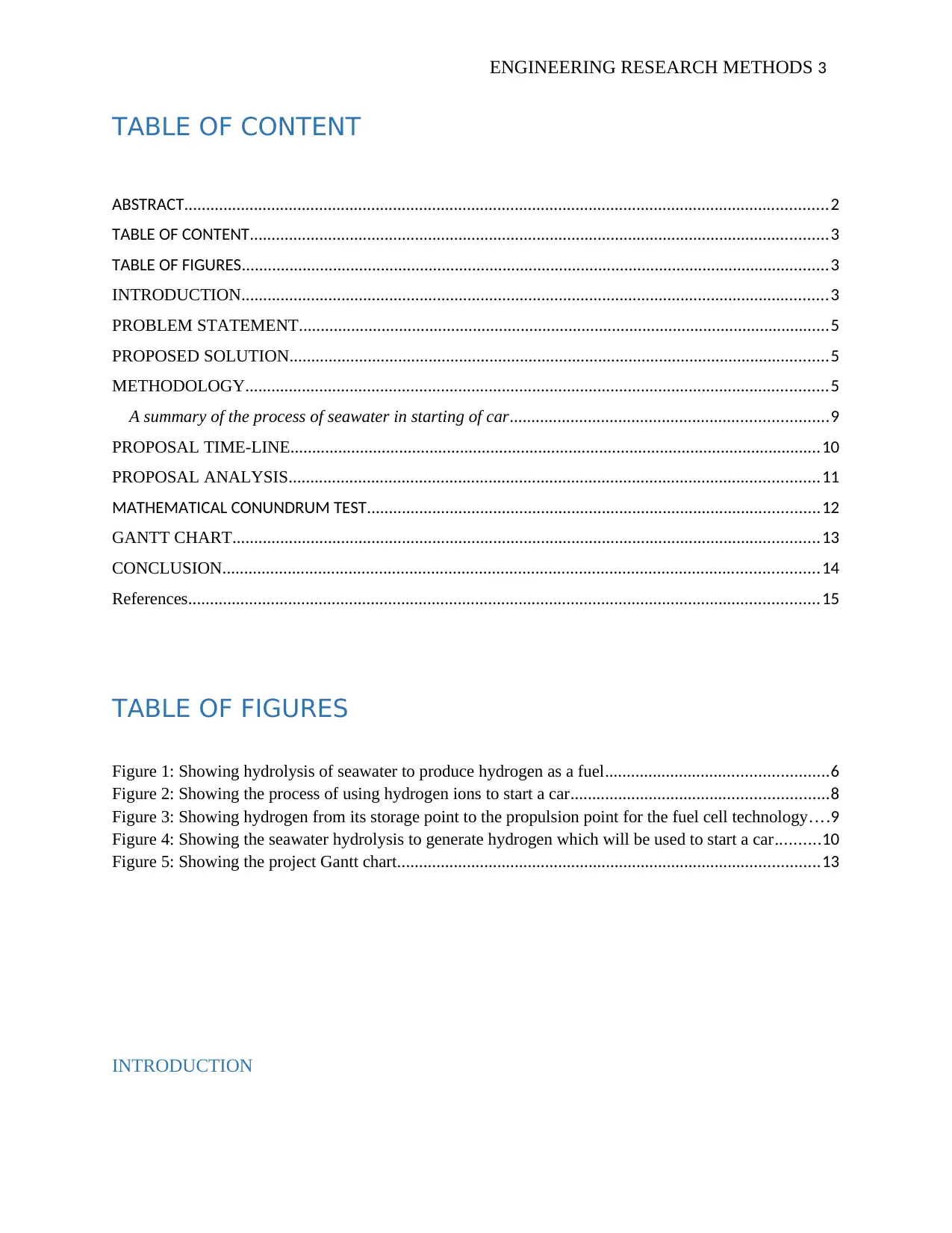
ENGINEERING RESEARCH METHODS 3
TABLE OF CONTENT
ABSTRACT....................................................................................................................................................2
TABLE OF CONTENT.....................................................................................................................................3
TABLE OF FIGURES.......................................................................................................................................3
INTRODUCTION.......................................................................................................................................3
PROBLEM STATEMENT..........................................................................................................................5
PROPOSED SOLUTION............................................................................................................................5
METHODOLOGY......................................................................................................................................5
A summary of the process of seawater in starting of car.........................................................................9
PROPOSAL TIME-LINE..........................................................................................................................10
PROPOSAL ANALYSIS..........................................................................................................................11
MATHEMATICAL CONUNDRUM TEST........................................................................................................12
GANTT CHART.......................................................................................................................................13
CONCLUSION.........................................................................................................................................14
References.................................................................................................................................................15
TABLE OF FIGURES
Figure 1: Showing hydrolysis of seawater to produce hydrogen as a fuel...................................................6
Figure 2: Showing the process of using hydrogen ions to start a car...........................................................8
Figure 3: Showing hydrogen from its storage point to the propulsion point for the fuel cell technology....9
Figure 4: Showing the seawater hydrolysis to generate hydrogen which will be used to start a car..........10
Figure 5: Showing the project Gantt chart.................................................................................................13
INTRODUCTION
TABLE OF CONTENT
ABSTRACT....................................................................................................................................................2
TABLE OF CONTENT.....................................................................................................................................3
TABLE OF FIGURES.......................................................................................................................................3
INTRODUCTION.......................................................................................................................................3
PROBLEM STATEMENT..........................................................................................................................5
PROPOSED SOLUTION............................................................................................................................5
METHODOLOGY......................................................................................................................................5
A summary of the process of seawater in starting of car.........................................................................9
PROPOSAL TIME-LINE..........................................................................................................................10
PROPOSAL ANALYSIS..........................................................................................................................11
MATHEMATICAL CONUNDRUM TEST........................................................................................................12
GANTT CHART.......................................................................................................................................13
CONCLUSION.........................................................................................................................................14
References.................................................................................................................................................15
TABLE OF FIGURES
Figure 1: Showing hydrolysis of seawater to produce hydrogen as a fuel...................................................6
Figure 2: Showing the process of using hydrogen ions to start a car...........................................................8
Figure 3: Showing hydrogen from its storage point to the propulsion point for the fuel cell technology....9
Figure 4: Showing the seawater hydrolysis to generate hydrogen which will be used to start a car..........10
Figure 5: Showing the project Gantt chart.................................................................................................13
INTRODUCTION
⊘ This is a preview!⊘
Do you want full access?
Subscribe today to unlock all pages.

Trusted by 1+ million students worldwide
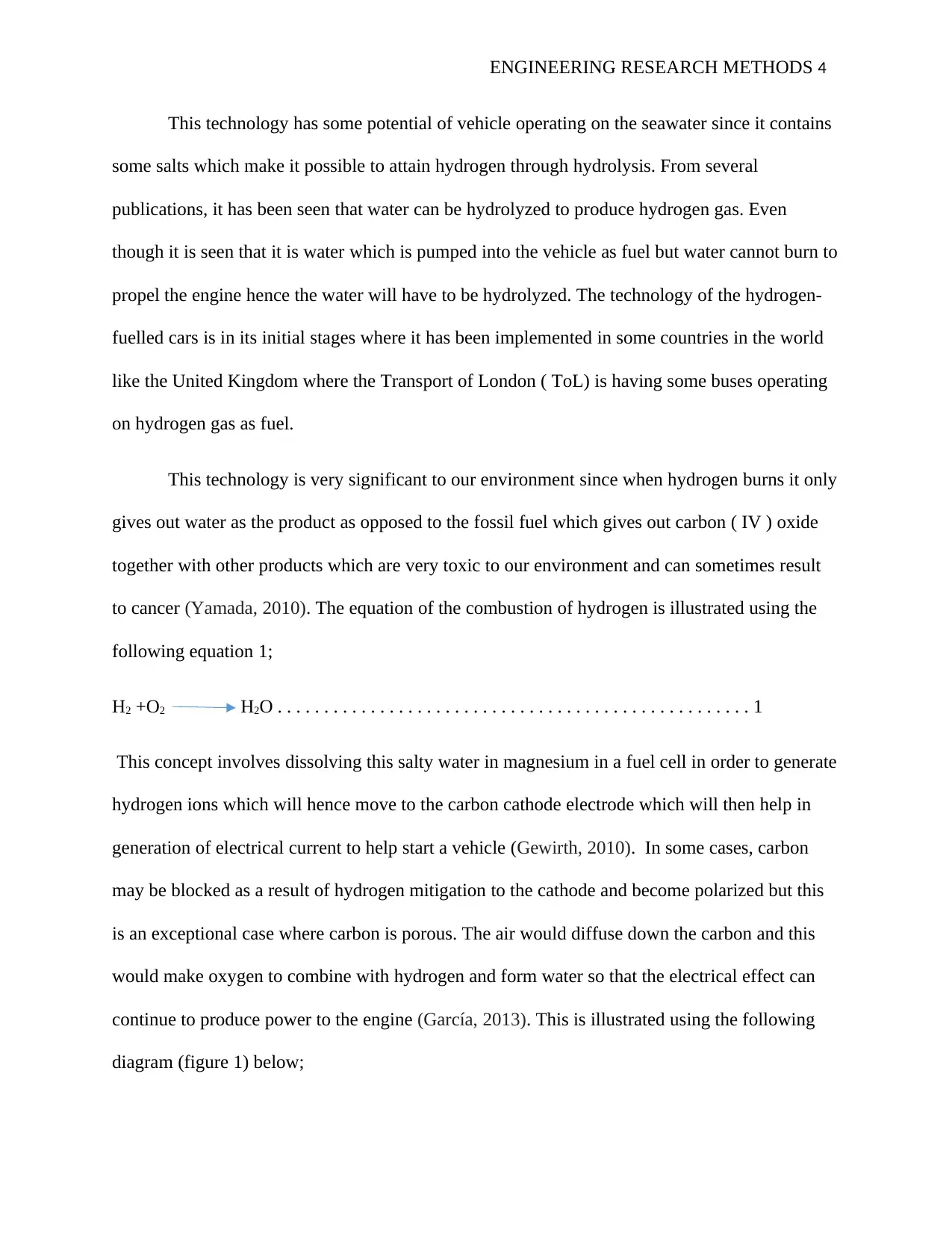
ENGINEERING RESEARCH METHODS 4
This technology has some potential of vehicle operating on the seawater since it contains
some salts which make it possible to attain hydrogen through hydrolysis. From several
publications, it has been seen that water can be hydrolyzed to produce hydrogen gas. Even
though it is seen that it is water which is pumped into the vehicle as fuel but water cannot burn to
propel the engine hence the water will have to be hydrolyzed. The technology of the hydrogen-
fuelled cars is in its initial stages where it has been implemented in some countries in the world
like the United Kingdom where the Transport of London ( ToL) is having some buses operating
on hydrogen gas as fuel.
This technology is very significant to our environment since when hydrogen burns it only
gives out water as the product as opposed to the fossil fuel which gives out carbon ( IV ) oxide
together with other products which are very toxic to our environment and can sometimes result
to cancer (Yamada, 2010). The equation of the combustion of hydrogen is illustrated using the
following equation 1;
H2 +O2 H2O . . . . . . . . . . . . . . . . . . . . . . . . . . . . . . . . . . . . . . . . . . . . . . . . . . . 1
This concept involves dissolving this salty water in magnesium in a fuel cell in order to generate
hydrogen ions which will hence move to the carbon cathode electrode which will then help in
generation of electrical current to help start a vehicle (Gewirth, 2010). In some cases, carbon
may be blocked as a result of hydrogen mitigation to the cathode and become polarized but this
is an exceptional case where carbon is porous. The air would diffuse down the carbon and this
would make oxygen to combine with hydrogen and form water so that the electrical effect can
continue to produce power to the engine (García, 2013). This is illustrated using the following
diagram (figure 1) below;
This technology has some potential of vehicle operating on the seawater since it contains
some salts which make it possible to attain hydrogen through hydrolysis. From several
publications, it has been seen that water can be hydrolyzed to produce hydrogen gas. Even
though it is seen that it is water which is pumped into the vehicle as fuel but water cannot burn to
propel the engine hence the water will have to be hydrolyzed. The technology of the hydrogen-
fuelled cars is in its initial stages where it has been implemented in some countries in the world
like the United Kingdom where the Transport of London ( ToL) is having some buses operating
on hydrogen gas as fuel.
This technology is very significant to our environment since when hydrogen burns it only
gives out water as the product as opposed to the fossil fuel which gives out carbon ( IV ) oxide
together with other products which are very toxic to our environment and can sometimes result
to cancer (Yamada, 2010). The equation of the combustion of hydrogen is illustrated using the
following equation 1;
H2 +O2 H2O . . . . . . . . . . . . . . . . . . . . . . . . . . . . . . . . . . . . . . . . . . . . . . . . . . . 1
This concept involves dissolving this salty water in magnesium in a fuel cell in order to generate
hydrogen ions which will hence move to the carbon cathode electrode which will then help in
generation of electrical current to help start a vehicle (Gewirth, 2010). In some cases, carbon
may be blocked as a result of hydrogen mitigation to the cathode and become polarized but this
is an exceptional case where carbon is porous. The air would diffuse down the carbon and this
would make oxygen to combine with hydrogen and form water so that the electrical effect can
continue to produce power to the engine (García, 2013). This is illustrated using the following
diagram (figure 1) below;
Paraphrase This Document
Need a fresh take? Get an instant paraphrase of this document with our AI Paraphraser
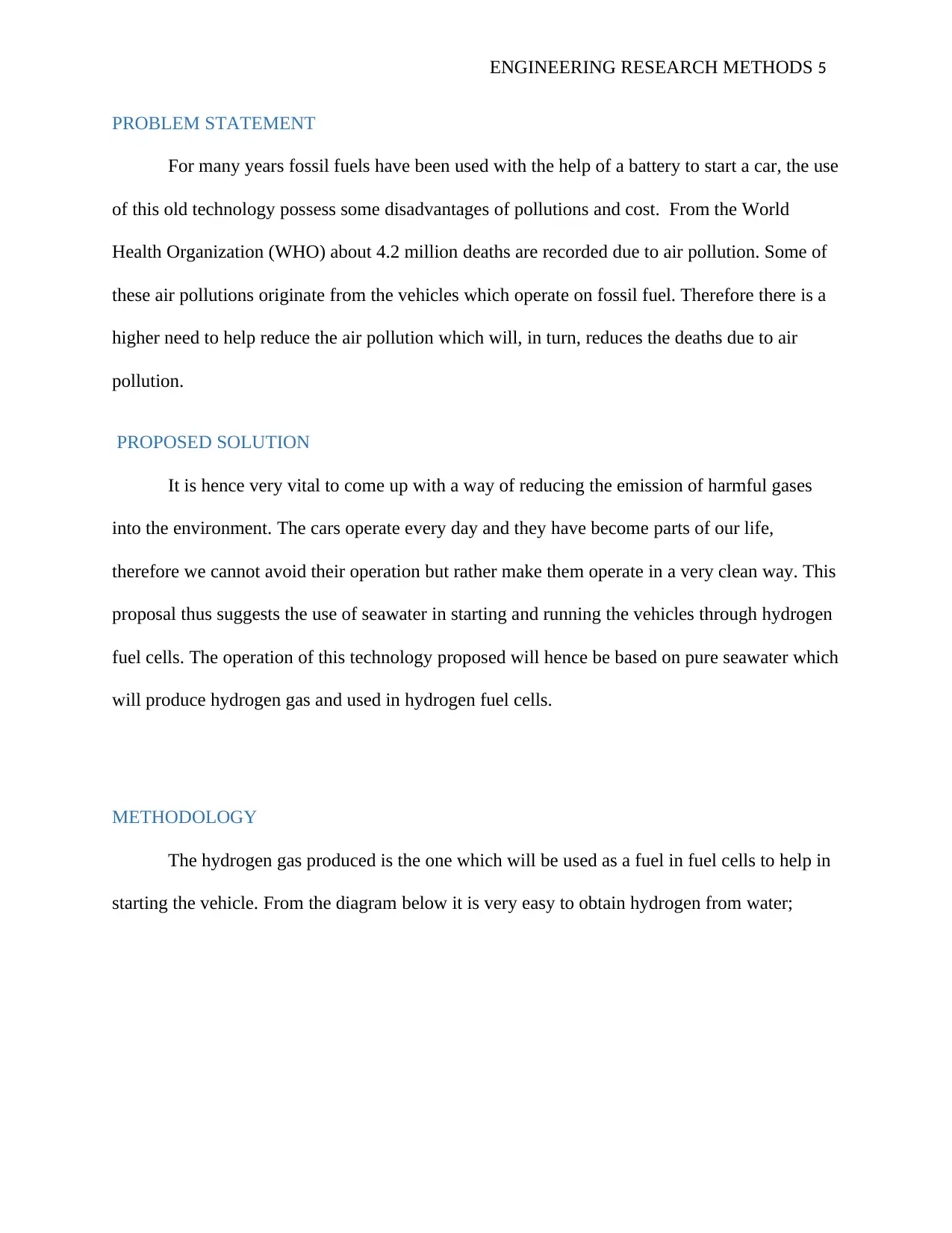
ENGINEERING RESEARCH METHODS 5
PROBLEM STATEMENT
For many years fossil fuels have been used with the help of a battery to start a car, the use
of this old technology possess some disadvantages of pollutions and cost. From the World
Health Organization (WHO) about 4.2 million deaths are recorded due to air pollution. Some of
these air pollutions originate from the vehicles which operate on fossil fuel. Therefore there is a
higher need to help reduce the air pollution which will, in turn, reduces the deaths due to air
pollution.
PROPOSED SOLUTION
It is hence very vital to come up with a way of reducing the emission of harmful gases
into the environment. The cars operate every day and they have become parts of our life,
therefore we cannot avoid their operation but rather make them operate in a very clean way. This
proposal thus suggests the use of seawater in starting and running the vehicles through hydrogen
fuel cells. The operation of this technology proposed will hence be based on pure seawater which
will produce hydrogen gas and used in hydrogen fuel cells.
METHODOLOGY
The hydrogen gas produced is the one which will be used as a fuel in fuel cells to help in
starting the vehicle. From the diagram below it is very easy to obtain hydrogen from water;
PROBLEM STATEMENT
For many years fossil fuels have been used with the help of a battery to start a car, the use
of this old technology possess some disadvantages of pollutions and cost. From the World
Health Organization (WHO) about 4.2 million deaths are recorded due to air pollution. Some of
these air pollutions originate from the vehicles which operate on fossil fuel. Therefore there is a
higher need to help reduce the air pollution which will, in turn, reduces the deaths due to air
pollution.
PROPOSED SOLUTION
It is hence very vital to come up with a way of reducing the emission of harmful gases
into the environment. The cars operate every day and they have become parts of our life,
therefore we cannot avoid their operation but rather make them operate in a very clean way. This
proposal thus suggests the use of seawater in starting and running the vehicles through hydrogen
fuel cells. The operation of this technology proposed will hence be based on pure seawater which
will produce hydrogen gas and used in hydrogen fuel cells.
METHODOLOGY
The hydrogen gas produced is the one which will be used as a fuel in fuel cells to help in
starting the vehicle. From the diagram below it is very easy to obtain hydrogen from water;
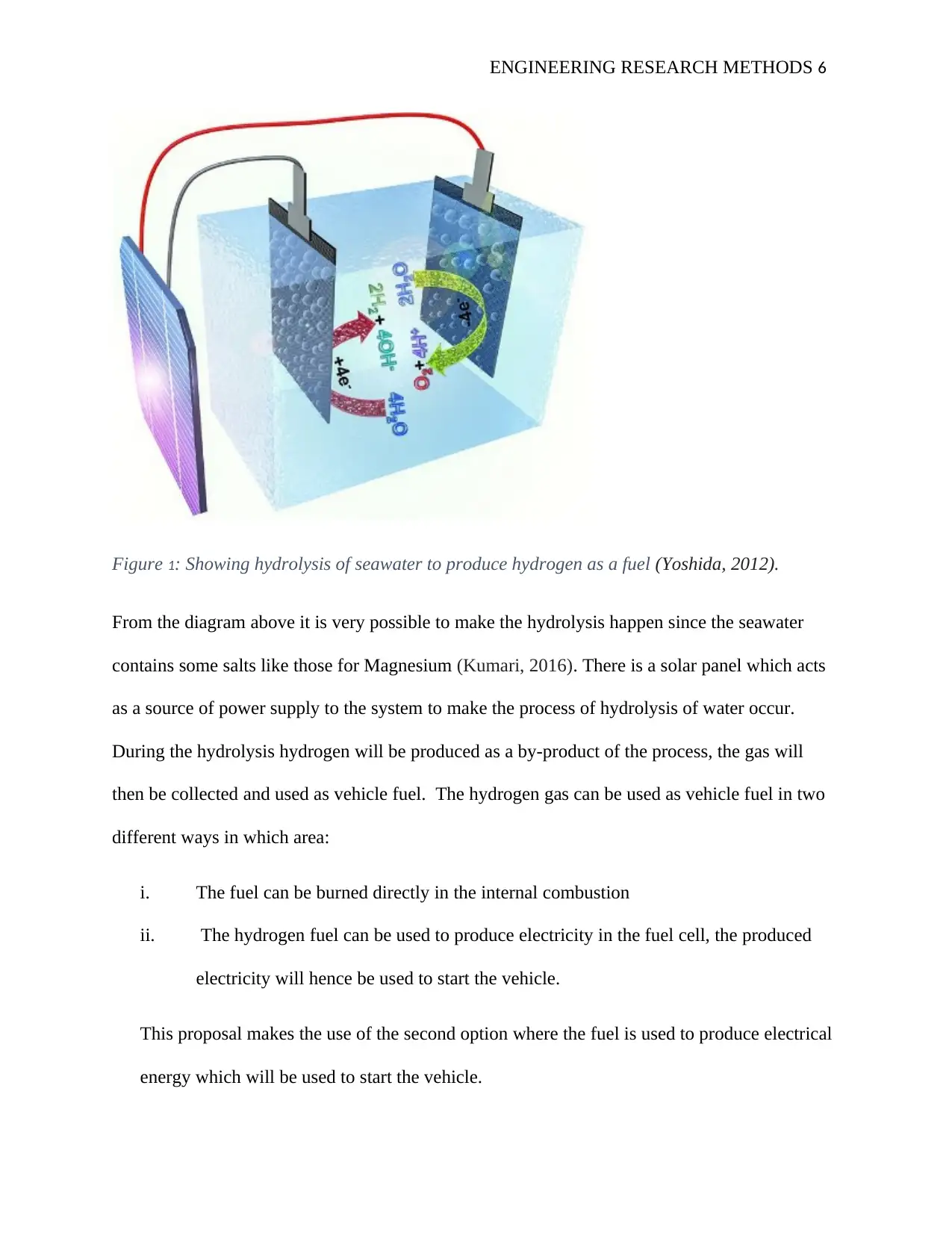
ENGINEERING RESEARCH METHODS 6
Figure 1: Showing hydrolysis of seawater to produce hydrogen as a fuel (Yoshida, 2012).
From the diagram above it is very possible to make the hydrolysis happen since the seawater
contains some salts like those for Magnesium (Kumari, 2016). There is a solar panel which acts
as a source of power supply to the system to make the process of hydrolysis of water occur.
During the hydrolysis hydrogen will be produced as a by-product of the process, the gas will
then be collected and used as vehicle fuel. The hydrogen gas can be used as vehicle fuel in two
different ways in which area:
i. The fuel can be burned directly in the internal combustion
ii. The hydrogen fuel can be used to produce electricity in the fuel cell, the produced
electricity will hence be used to start the vehicle.
This proposal makes the use of the second option where the fuel is used to produce electrical
energy which will be used to start the vehicle.
Figure 1: Showing hydrolysis of seawater to produce hydrogen as a fuel (Yoshida, 2012).
From the diagram above it is very possible to make the hydrolysis happen since the seawater
contains some salts like those for Magnesium (Kumari, 2016). There is a solar panel which acts
as a source of power supply to the system to make the process of hydrolysis of water occur.
During the hydrolysis hydrogen will be produced as a by-product of the process, the gas will
then be collected and used as vehicle fuel. The hydrogen gas can be used as vehicle fuel in two
different ways in which area:
i. The fuel can be burned directly in the internal combustion
ii. The hydrogen fuel can be used to produce electricity in the fuel cell, the produced
electricity will hence be used to start the vehicle.
This proposal makes the use of the second option where the fuel is used to produce electrical
energy which will be used to start the vehicle.
⊘ This is a preview!⊘
Do you want full access?
Subscribe today to unlock all pages.

Trusted by 1+ million students worldwide
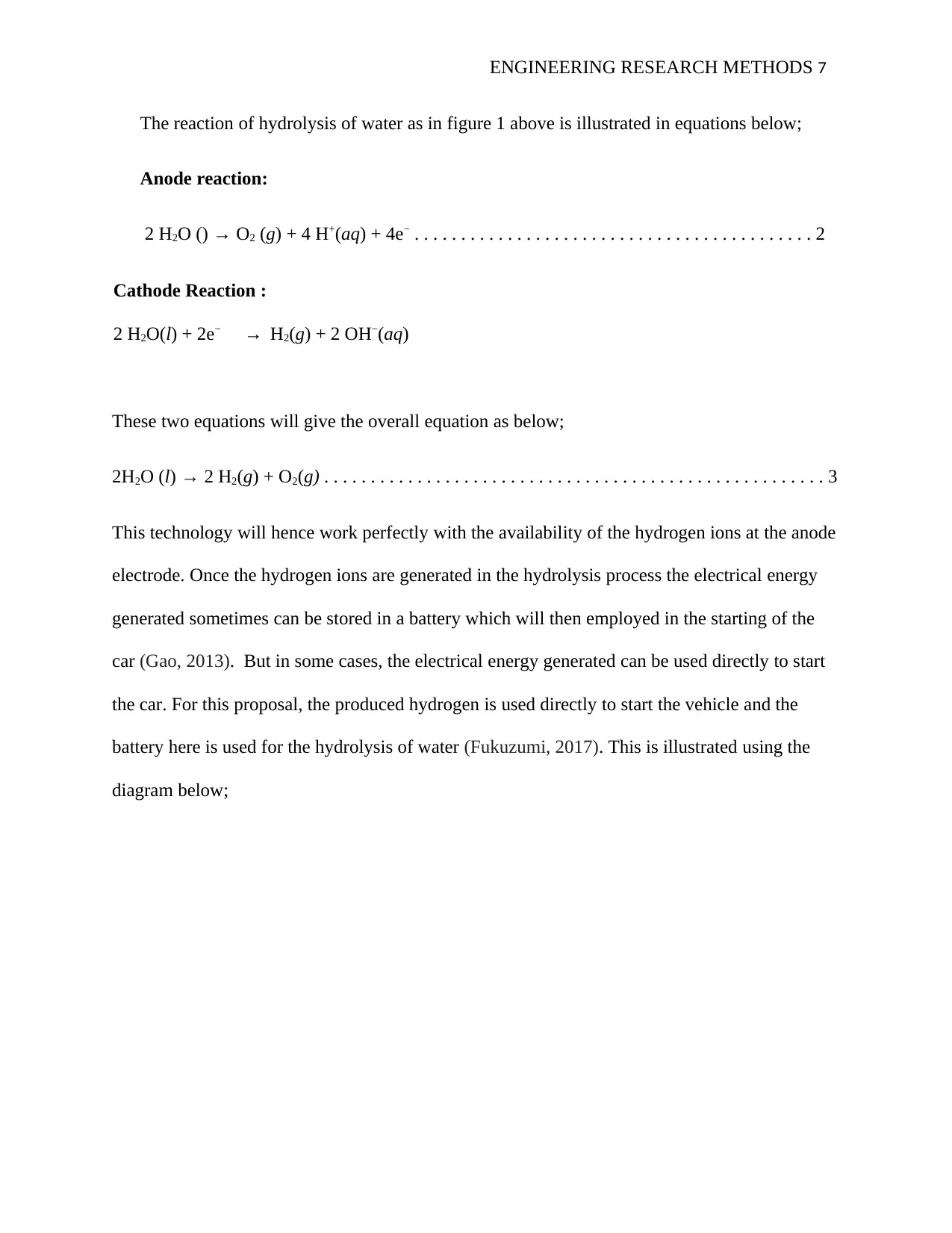
ENGINEERING RESEARCH METHODS 7
The reaction of hydrolysis of water as in figure 1 above is illustrated in equations below;
Anode reaction:
2 H2O () → O2 (g) + 4 H+(aq) + 4e− . . . . . . . . . . . . . . . . . . . . . . . . . . . . . . . . . . . . . . . . . . . 2
Cathode Reaction :
2 H2O(l) + 2e− → H2(g) + 2 OH−(aq)
These two equations will give the overall equation as below;
2H2O (l) → 2 H2(g) + O2(g) . . . . . . . . . . . . . . . . . . . . . . . . . . . . . . . . . . . . . . . . . . . . . . . . . . . . . . 3
This technology will hence work perfectly with the availability of the hydrogen ions at the anode
electrode. Once the hydrogen ions are generated in the hydrolysis process the electrical energy
generated sometimes can be stored in a battery which will then employed in the starting of the
car (Gao, 2013). But in some cases, the electrical energy generated can be used directly to start
the car. For this proposal, the produced hydrogen is used directly to start the vehicle and the
battery here is used for the hydrolysis of water (Fukuzumi, 2017). This is illustrated using the
diagram below;
The reaction of hydrolysis of water as in figure 1 above is illustrated in equations below;
Anode reaction:
2 H2O () → O2 (g) + 4 H+(aq) + 4e− . . . . . . . . . . . . . . . . . . . . . . . . . . . . . . . . . . . . . . . . . . . 2
Cathode Reaction :
2 H2O(l) + 2e− → H2(g) + 2 OH−(aq)
These two equations will give the overall equation as below;
2H2O (l) → 2 H2(g) + O2(g) . . . . . . . . . . . . . . . . . . . . . . . . . . . . . . . . . . . . . . . . . . . . . . . . . . . . . . 3
This technology will hence work perfectly with the availability of the hydrogen ions at the anode
electrode. Once the hydrogen ions are generated in the hydrolysis process the electrical energy
generated sometimes can be stored in a battery which will then employed in the starting of the
car (Gao, 2013). But in some cases, the electrical energy generated can be used directly to start
the car. For this proposal, the produced hydrogen is used directly to start the vehicle and the
battery here is used for the hydrolysis of water (Fukuzumi, 2017). This is illustrated using the
diagram below;
Paraphrase This Document
Need a fresh take? Get an instant paraphrase of this document with our AI Paraphraser
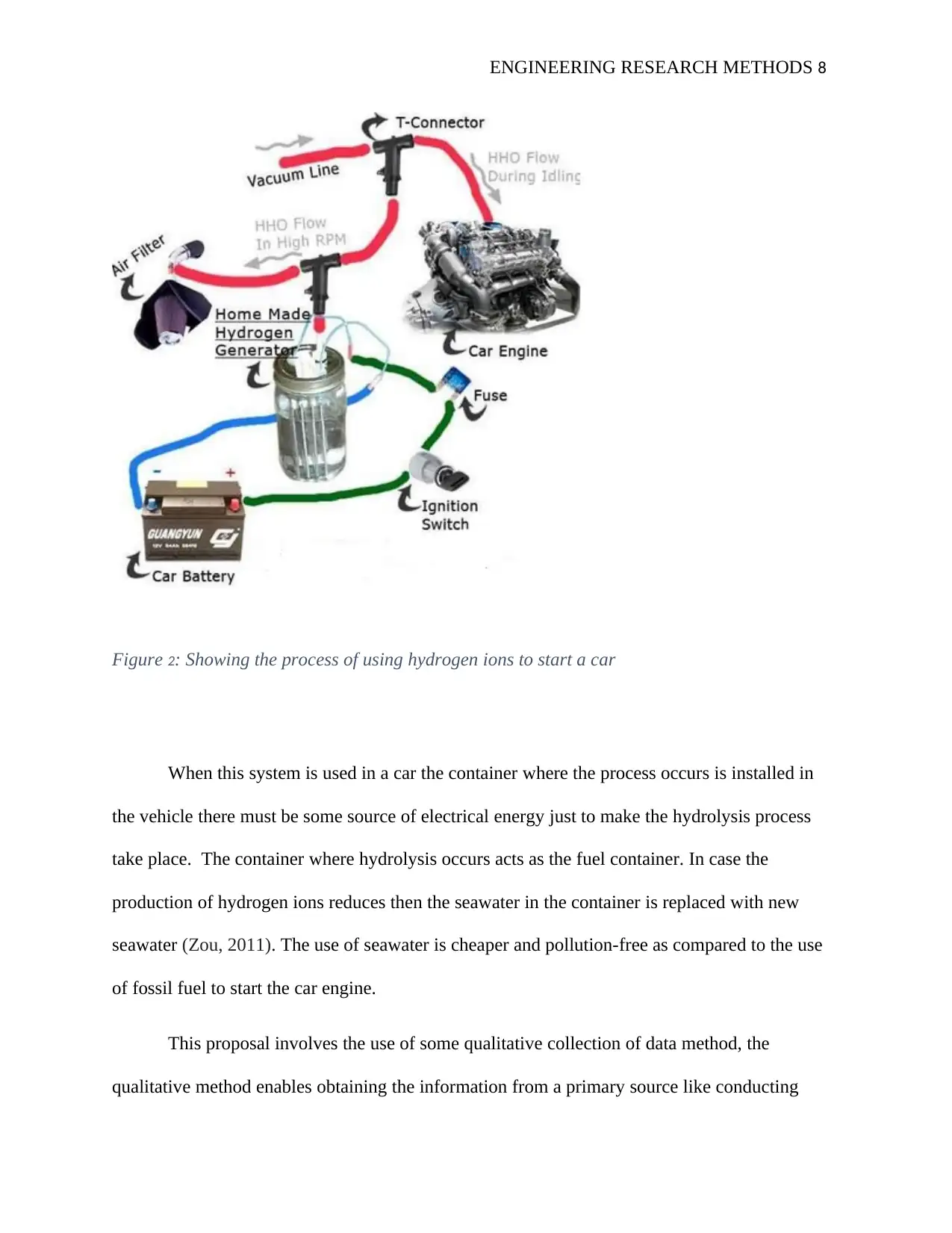
ENGINEERING RESEARCH METHODS 8
Figure 2: Showing the process of using hydrogen ions to start a car
When this system is used in a car the container where the process occurs is installed in
the vehicle there must be some source of electrical energy just to make the hydrolysis process
take place. The container where hydrolysis occurs acts as the fuel container. In case the
production of hydrogen ions reduces then the seawater in the container is replaced with new
seawater (Zou, 2011). The use of seawater is cheaper and pollution-free as compared to the use
of fossil fuel to start the car engine.
This proposal involves the use of some qualitative collection of data method, the
qualitative method enables obtaining the information from a primary source like conducting
Figure 2: Showing the process of using hydrogen ions to start a car
When this system is used in a car the container where the process occurs is installed in
the vehicle there must be some source of electrical energy just to make the hydrolysis process
take place. The container where hydrolysis occurs acts as the fuel container. In case the
production of hydrogen ions reduces then the seawater in the container is replaced with new
seawater (Zou, 2011). The use of seawater is cheaper and pollution-free as compared to the use
of fossil fuel to start the car engine.
This proposal involves the use of some qualitative collection of data method, the
qualitative method enables obtaining the information from a primary source like conducting
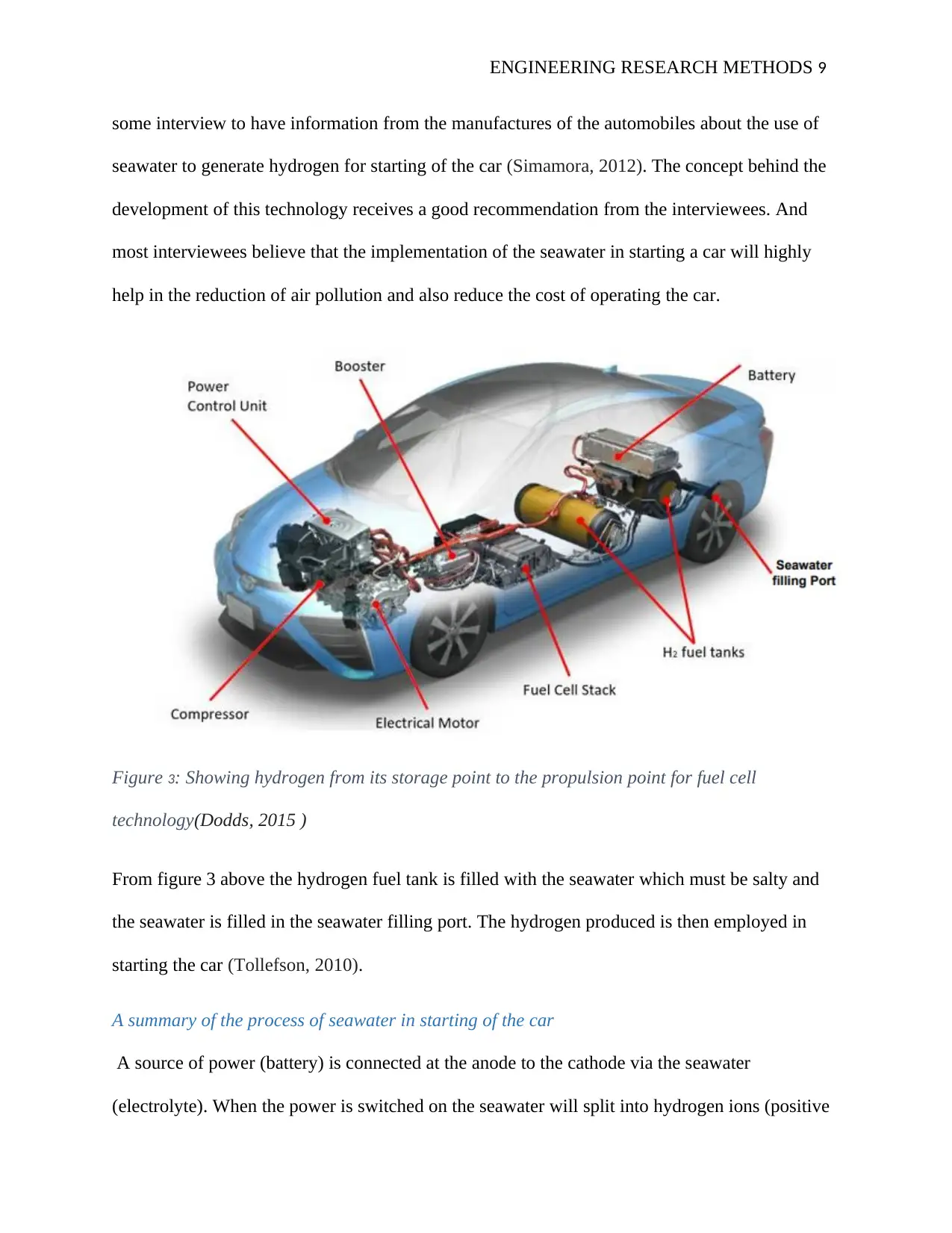
ENGINEERING RESEARCH METHODS 9
some interview to have information from the manufactures of the automobiles about the use of
seawater to generate hydrogen for starting of the car (Simamora, 2012). The concept behind the
development of this technology receives a good recommendation from the interviewees. And
most interviewees believe that the implementation of the seawater in starting a car will highly
help in the reduction of air pollution and also reduce the cost of operating the car.
Figure 3: Showing hydrogen from its storage point to the propulsion point for fuel cell
technology(Dodds, 2015 )
From figure 3 above the hydrogen fuel tank is filled with the seawater which must be salty and
the seawater is filled in the seawater filling port. The hydrogen produced is then employed in
starting the car (Tollefson, 2010).
A summary of the process of seawater in starting of the car
A source of power (battery) is connected at the anode to the cathode via the seawater
(electrolyte). When the power is switched on the seawater will split into hydrogen ions (positive
some interview to have information from the manufactures of the automobiles about the use of
seawater to generate hydrogen for starting of the car (Simamora, 2012). The concept behind the
development of this technology receives a good recommendation from the interviewees. And
most interviewees believe that the implementation of the seawater in starting a car will highly
help in the reduction of air pollution and also reduce the cost of operating the car.
Figure 3: Showing hydrogen from its storage point to the propulsion point for fuel cell
technology(Dodds, 2015 )
From figure 3 above the hydrogen fuel tank is filled with the seawater which must be salty and
the seawater is filled in the seawater filling port. The hydrogen produced is then employed in
starting the car (Tollefson, 2010).
A summary of the process of seawater in starting of the car
A source of power (battery) is connected at the anode to the cathode via the seawater
(electrolyte). When the power is switched on the seawater will split into hydrogen ions (positive
⊘ This is a preview!⊘
Do you want full access?
Subscribe today to unlock all pages.

Trusted by 1+ million students worldwide
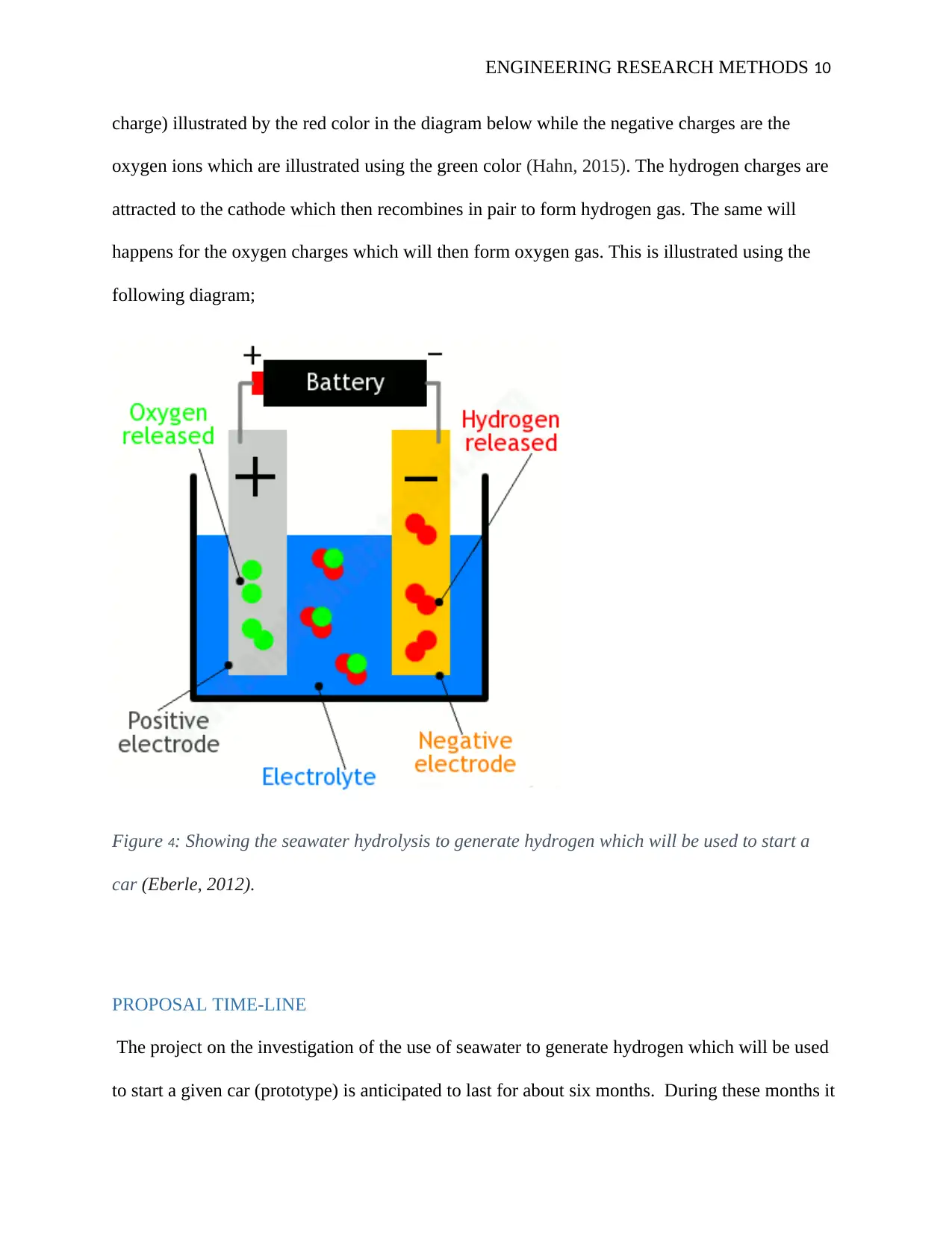
ENGINEERING RESEARCH METHODS 10
charge) illustrated by the red color in the diagram below while the negative charges are the
oxygen ions which are illustrated using the green color (Hahn, 2015). The hydrogen charges are
attracted to the cathode which then recombines in pair to form hydrogen gas. The same will
happens for the oxygen charges which will then form oxygen gas. This is illustrated using the
following diagram;
Figure 4: Showing the seawater hydrolysis to generate hydrogen which will be used to start a
car (Eberle, 2012).
PROPOSAL TIME-LINE
The project on the investigation of the use of seawater to generate hydrogen which will be used
to start a given car (prototype) is anticipated to last for about six months. During these months it
charge) illustrated by the red color in the diagram below while the negative charges are the
oxygen ions which are illustrated using the green color (Hahn, 2015). The hydrogen charges are
attracted to the cathode which then recombines in pair to form hydrogen gas. The same will
happens for the oxygen charges which will then form oxygen gas. This is illustrated using the
following diagram;
Figure 4: Showing the seawater hydrolysis to generate hydrogen which will be used to start a
car (Eberle, 2012).
PROPOSAL TIME-LINE
The project on the investigation of the use of seawater to generate hydrogen which will be used
to start a given car (prototype) is anticipated to last for about six months. During these months it
Paraphrase This Document
Need a fresh take? Get an instant paraphrase of this document with our AI Paraphraser
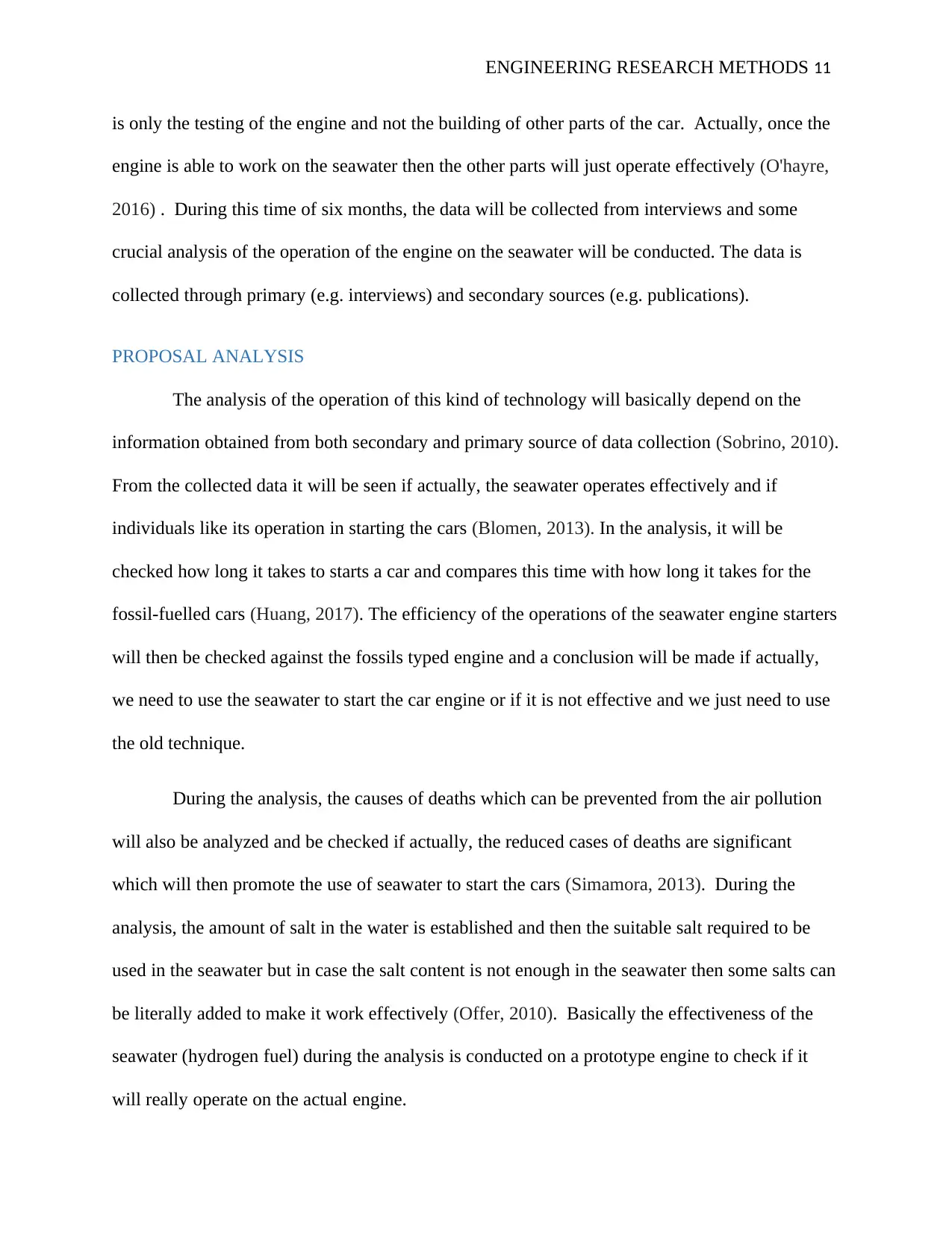
ENGINEERING RESEARCH METHODS 11
is only the testing of the engine and not the building of other parts of the car. Actually, once the
engine is able to work on the seawater then the other parts will just operate effectively (O'hayre,
2016) . During this time of six months, the data will be collected from interviews and some
crucial analysis of the operation of the engine on the seawater will be conducted. The data is
collected through primary (e.g. interviews) and secondary sources (e.g. publications).
PROPOSAL ANALYSIS
The analysis of the operation of this kind of technology will basically depend on the
information obtained from both secondary and primary source of data collection (Sobrino, 2010).
From the collected data it will be seen if actually, the seawater operates effectively and if
individuals like its operation in starting the cars (Blomen, 2013). In the analysis, it will be
checked how long it takes to starts a car and compares this time with how long it takes for the
fossil-fuelled cars (Huang, 2017). The efficiency of the operations of the seawater engine starters
will then be checked against the fossils typed engine and a conclusion will be made if actually,
we need to use the seawater to start the car engine or if it is not effective and we just need to use
the old technique.
During the analysis, the causes of deaths which can be prevented from the air pollution
will also be analyzed and be checked if actually, the reduced cases of deaths are significant
which will then promote the use of seawater to start the cars (Simamora, 2013). During the
analysis, the amount of salt in the water is established and then the suitable salt required to be
used in the seawater but in case the salt content is not enough in the seawater then some salts can
be literally added to make it work effectively (Offer, 2010). Basically the effectiveness of the
seawater (hydrogen fuel) during the analysis is conducted on a prototype engine to check if it
will really operate on the actual engine.
is only the testing of the engine and not the building of other parts of the car. Actually, once the
engine is able to work on the seawater then the other parts will just operate effectively (O'hayre,
2016) . During this time of six months, the data will be collected from interviews and some
crucial analysis of the operation of the engine on the seawater will be conducted. The data is
collected through primary (e.g. interviews) and secondary sources (e.g. publications).
PROPOSAL ANALYSIS
The analysis of the operation of this kind of technology will basically depend on the
information obtained from both secondary and primary source of data collection (Sobrino, 2010).
From the collected data it will be seen if actually, the seawater operates effectively and if
individuals like its operation in starting the cars (Blomen, 2013). In the analysis, it will be
checked how long it takes to starts a car and compares this time with how long it takes for the
fossil-fuelled cars (Huang, 2017). The efficiency of the operations of the seawater engine starters
will then be checked against the fossils typed engine and a conclusion will be made if actually,
we need to use the seawater to start the car engine or if it is not effective and we just need to use
the old technique.
During the analysis, the causes of deaths which can be prevented from the air pollution
will also be analyzed and be checked if actually, the reduced cases of deaths are significant
which will then promote the use of seawater to start the cars (Simamora, 2013). During the
analysis, the amount of salt in the water is established and then the suitable salt required to be
used in the seawater but in case the salt content is not enough in the seawater then some salts can
be literally added to make it work effectively (Offer, 2010). Basically the effectiveness of the
seawater (hydrogen fuel) during the analysis is conducted on a prototype engine to check if it
will really operate on the actual engine.

ENGINEERING RESEARCH METHODS 12
MATHEMATICAL CONUNDRUM TEST
The Mathematical conundrum test is like a mathematical puzzle, and in this project, it is conducted and
the results are given below;
From different values used in running the test of the conundrum used randomly the below are the
results given in the fourth row with the first three rows are the conundrum test input values;
2, 4, 9, 0.41
1, 2, 3, 52.26
8, 7, 9, 3.88
7, 8, 9, 3.01
1, 4, 5, 47.62
6, 4, 5, 50.25
8, 4, 5, 49.52
2, 4, 7, 35.16
7, 4, 8, 21.32
0.7, 0.4, 1, 34.52
2, 4, 1, 33.6
3, 7, 9, 3.28
8, 9, 10, 0
3, 7, 4, 51.82
Basically the test running and the output is given as below
MATHEMATICAL CONUNDRUM TEST
The Mathematical conundrum test is like a mathematical puzzle, and in this project, it is conducted and
the results are given below;
From different values used in running the test of the conundrum used randomly the below are the
results given in the fourth row with the first three rows are the conundrum test input values;
2, 4, 9, 0.41
1, 2, 3, 52.26
8, 7, 9, 3.88
7, 8, 9, 3.01
1, 4, 5, 47.62
6, 4, 5, 50.25
8, 4, 5, 49.52
2, 4, 7, 35.16
7, 4, 8, 21.32
0.7, 0.4, 1, 34.52
2, 4, 1, 33.6
3, 7, 9, 3.28
8, 9, 10, 0
3, 7, 4, 51.82
Basically the test running and the output is given as below
⊘ This is a preview!⊘
Do you want full access?
Subscribe today to unlock all pages.

Trusted by 1+ million students worldwide
1 out of 17
Related Documents
Your All-in-One AI-Powered Toolkit for Academic Success.
+13062052269
info@desklib.com
Available 24*7 on WhatsApp / Email
![[object Object]](/_next/static/media/star-bottom.7253800d.svg)
Unlock your academic potential
Copyright © 2020–2025 A2Z Services. All Rights Reserved. Developed and managed by ZUCOL.


